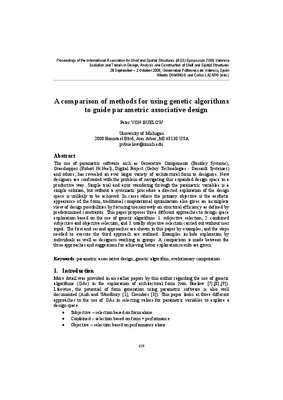JavaScript is disabled for your browser. Some features of this site may not work without it.
Buscar en RiuNet
Listar
Mi cuenta
Estadísticas
Ayuda RiuNet
Admin. UPV
A comparison of methods for using genetic algorithms to guide parametric associative design
Mostrar el registro sencillo del ítem
Ficheros en el ítem
| dc.contributor.author | VAN BUELOW, Peter
|
|
| dc.contributor.editor | Domingo Cabo, Alberto
|
es_ES |
| dc.contributor.editor | Lázaro Fernández, Carlos Manuel
|
es_ES |
| dc.date.accessioned | 2009-12-18T11:09:21Z | |
| dc.date.available | 2009-12-18T11:09:21Z | |
| dc.date.issued | 2009-12-18T11:09:21Z | |
| dc.identifier.isbn | 978-84-8363-461-5 | |
| dc.identifier.uri | http://hdl.handle.net/10251/6714 | |
| dc.description | p. 629-639 | en_EN |
| dc.description.abstract | The use of parametric software such as Generative Components (Bentley Systems), Grasshopper (Robert NcNeel), Digital Project (Gehry Technologies - Dassault Systemes) and others, has revealed an ever larger variety of architectural form to designers. Now designers are confronted with the problem of navigating this expanded design space in a productive way. Simple trial and error wandering through the parametric variables is a simple solution, but without a systematic procedure a directed exploration of the design space is unlikely to be achieved. In cases where the primary objective is the aesthetic appearance of the form, traditional computational optimization also gives an incomplete view of design possibilities by focusing too narrowly on structural efficiency as defined by predetermined constraints. This paper proposes three different approaches to design space exploration based on the use of genetic algorithms: 1. subjective selection, 2. combined subjective and objective selection, and 3. totally objective selection carried out without user input. The first and second approaches are shown in this paper by examples, and the steps needed to execute the third approach are outlined. Examples include exploration by individuals as well as designers working in groups. A comparison is made between the three approaches and suggestions for achieving better exploration results are given. | en_EN |
| dc.language | Inglés | en_EN |
| dc.publisher | Editorial Universitat Politècnica de València | es_ES |
| dc.relation.ispartof | Symposium of the International Association for Shell and Spatial Structures (50th. 2009. Valencia). Evolution and Trends in Design, Analysis and Construction of Shell and Spatial Structures : Proceedings | en_EN |
| dc.rights | Reserva de todos los derechos | en_EN |
| dc.subject | Parametric associative design | en_EN |
| dc.subject | Genetic algorithm | en_EN |
| dc.subject | Evolutionary computation | en_EN |
| dc.title | A comparison of methods for using genetic algorithms to guide parametric associative design | en_EN |
| dc.type | Comunicación en congreso | en_EN |
| dc.rights.accessRights | Abierto | es_ES |
| dc.description.bibliographicCitation | Van Buelow, P. (2009). A comparison of methods for using genetic algorithms to guide parametric associative design. Editorial Universitat Politècnica de València. http://hdl.handle.net/10251/6714 | es_ES |
| dc.relation.conferencename | Symposium of the International Association for Shell and Spatial Structures | es_ES |
| dc.relation.conferencedate | 2009 | es_ES |
| dc.relation.conferenceplace | Valencia | es_ES |






